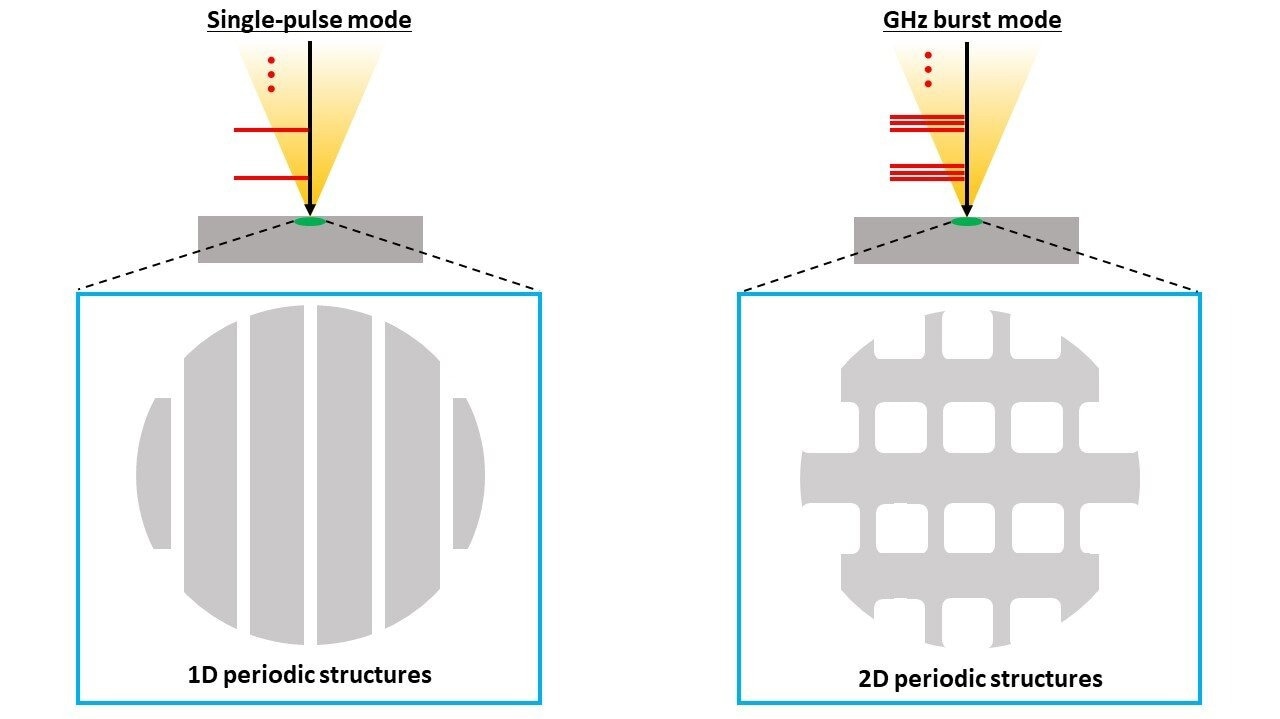In a paper published in the International Journal of Extreme Manufacturing, it was demonstrated that GHz burst mode femtosecond laser pulses could be used to create unique two-dimensional (2D) laser-induced periodic surface structures on silicon.

It's well known that irradiation of linearly polarized femtosecond laser pulses (single-pulse mode) creates one-dimensional (1D) laser-induced periodic surface structures (LIPSS) whose direction is perpendicular to the laser polarization direction. Interestingly, GHz burst mode femtosecond laser pulses can create unique 2D LIPSS which are composed of periodic surface structures both parallel and perpendicular to the laser polarization direction. The ability of the GHz burst mode enabling the fabrication of 2D LIPSS will diversify micro and nanostructuring to achieve highly functionalized material surfaces. Credit: Shota Kawabata, Shi Bai, Kotaro Obata, Godai Miyaji and Koji Sugioka.
Femtosecond laser beams with gigahertz (GHz) burst mode provide material processing capabilities that are not possible with the typical single-pulse irradiation strategy of femtosecond lasers.
An Introduction to LIPSS
Laser-induced periodic surface structures (LIPSS) are a promising tool for creating unique microscale and nanoscale structures on solid material surfaces. These structures are formed by irradiating the material with a series of linearly polarized laser pulses.
The orientation and period of LIPSS are affected by factors including pulse width, pulse energy, number of laser pulses, laser wavelength, direction of laser polarization, and material type.
How Are LIPSS Formed?
LIPSS may be produced on metals, semiconductors, and polymers. Femtosecond lasers are frequently utilized to generate laser-induced periodic surface structures with a period less than half of the wavelength, known as high spatial frequency LIPSS.
These structures have the potential to incorporate novel functionalities on the surfaces of materials. These features can include friction reduction, surface coloring, antireflective surfaces, and management of surface wettability.
With the exception of a few unique circumstances, the production of laser-induced periodic surface structures does not need any particular environment and may be accomplished using a basic and non-contact laser irradiation strategy. This is advantageous for use in industrial settings.
Researchers have theorized many processes for producing LIPSS using femtosecond laser beams. Some proposed methods include nanoplasma formation, self-organized structure formation, and excitation of surface plasmon polaritons. Unfortunately, a general consensus on the most effective process for LIPSS formation is yet to be reached.
How Can GHz Burst Mode Femtosecond Lasers Help?
One of the authors of the paper, Prof. Koji Sugioka, explained the critical phases of the research commenting, "In the process of the GHz burst mode ablation study, we considered that more controlled energy deposition as compared with the single-pulse mode may also offer some advantages to other kinds of materials processing. Then, we applied the GHz burst mode to LIPSS formation and succeeded in showing interesting results."
GHz burst mode femtosecond lasers are an innovative tool for material processing that offer a number of advantages over traditional ultrashort laser pulse (single-pulse mode) irradiation schemes.
Compared to single-pulse mode lasers, femtosecond lasers with GHz burst mode offer highly controlled energy deposition.
The term "burst mode" refers to the way in which the laser emits pulses. Instead of emitting one pulse at a time, GHz burst mode femtosecond lasers emit a series of pulses at a high frequency.
This burst of pulses allows for more precise control over the energy deposited on the material being processed, allowing for more precise and efficient ablation.
Additionally, the high-frequency pulses of GHz burst mode femtosecond lasers offer distinct features in materials processing that make them an ideal tool for creating unique micro and nanostructures, including LIPSS.
Findings of the Research
In this work, a gigahertz burst mode femtosecond laser was used to produce LIPSS to study its capacity to form novel microscale and nanoscale structures.
The team discovered that the GHz burst mode could create a one-of-a-kind 2D LIPSS comprised of periodic surface structures parallel and perpendicular to the direction of laser polarization.
The postulated formation mechanism was a synergistic contribution of the electromagnetic and hydrodynamic mechanisms.
The first and second intra-pulses in the GHz burst produced regular one-dimensional LIPSS on the silicon substrate, while the subsequent intra-pulses formed 2D LIPSS by producing periodic hotspots with an increased electric field in the nanoscale grooves of the 1D LIPSS via localized surface plasmon resonance.
The researchers also discovered that by modifying the GHz burst envelope wherein the strength of three intra-pulses was steadily lowered; they could construct more defined 2D LIPSS.
Further envelope optimization would result in a considerably more defined two-dimensional LIPSS with predefined periods. Surface characteristics of such 2D structures would be superior to those of typical 1D structures, opening up new possibilities for microscale and nanoscale fabrication.
Reference
Kawabata, S., Bai, S., Obata, K., Miyaji, G., & Sugioka, K. (2023). Two-dimensional laser-induced periodic surface structures formed on crystalline silicon by GHz burst mode femtosecond laser pulses. International Journal of Extreme Manufacturing, 5. Available at: https://doi.org/10.1088/2631-7990/acb133
Disclaimer: The views expressed here are those of the author expressed in their private capacity and do not necessarily represent the views of AZoM.com Limited T/A AZoNetwork the owner and operator of this website. This disclaimer forms part of the Terms and conditions of use of this website.